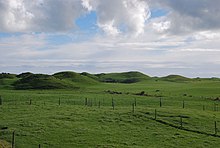Mount Taranaki
| Taranaki / Mount Egmont | ||
|---|---|---|
| height | 2518 m | |
| location | Taranaki , North Island , New Zealand | |
| Coordinates | 39 ° 18 ′ 0 ″ S , 174 ° 4 ′ 0 ″ E | |
|
|
||
| Type | Stratovolcano (solitary) | |
| Last eruption | 1854 | |
| First ascent | 1839 Ernst Dieffenbach, James Heberley | |
| Normal way | Hike | |
The Mount Taranaki is a solitary, 2,518 m high stratovolcano with perfect Conical pointed to the west of the North Island in New Zealand in the region Taranaki .
description
Geologically, it is considered to be a relatively young volcano that is said to have only become active almost 135,000 years ago. The last eruption is dated to the year 1854 and is said to have been accompanied by five larger eruptions in addition to lava flows .
Coming in from the Māori have always Taranaki called mountain was by the British navigator and explorer, Captain James Cook after the 2nd Earl of Egmont in Mount Egmont renamed. The mountain was later given its old name again, and only the surrounding Egmont National Park reminds of the noble who never had anything to do with New Zealand.
In the summer months from December to March, New Zealand's most climbed peak can be reached without climbing gear. However, the very changeable weather and the sometimes inexperienced mountaineers have their share in the highest death rate on all New Zealand mountains.
Three roads and several paths lead into the national park, which is well developed with tourism centers, hikers' huts and many hiking trails.
Māori mythology
In Māori mythology , Te Maunga o Taranaki is a mountain god who lived peacefully in the center of the North Island with the other gods Tongariro , Ruapehu and Ngauruhoe for many centuries . Taranaki's love for the Pihanga , which is overgrown with green forest , led to a quarrel with Tongariro , who also claimed her love. During the battle the earth shook and the sky turned black until Pihanga finally sided with Tongariro . Angry and deeply sad, Taranaki left the other mountains to settle in the direction of the sun on the coast, where he was trapped in his sleep by the Poukai mountain range and remained there forever. A stream of clear water sprang from the wounds inflicted on him, which is what is now the Whanganui River . Furthermore, there should be peace on earth as soon as the divorced gods get along again. Only then will Taranaki return to the vicinity of the other gods.
Geology of the area
The area around the Taranaki was shaped by numerous extreme mud and debris avalanches, so-called lahars , which extend up to 40 km into the surrounding area. Many small hills in the flat grassland bear witness to these events.
North of the dominant Taranaki is the lower, older volcano Mount Pouakai in the Kaitake mountain range in the national park.
Others
- The Taranaki formed a backdrop (as a replacement for the Fuji ) in the film drama The Last Samurai ( The Last Samurai ) of the American director Edward Zwick from the year of 2003.
- Ernst Dieffenbach , a German physician and natural scientist, and James Heberley , who both climbed the summit on December 23, 1839, are considered the first to climb the volcano . Heberley is said to have arrived 20 minutes earlier.
- At the end of December 2017, the Taranaki was granted the status of a legal person ( legal personality ), which gives him the legal protection that every New Zealand citizen is entitled to. From a legal point of view, any injuries and damage to the mountain are to be placed on the same level as violations of the rights of the Māori . Eight tribes who consider the mountain to be part of their whānau ( extended family ), together with the New Zealand government, take over the guardianship of the sacred mountain.
Photo gallery
- Mount Taranaki
Egmont National Park on a 2002 NASA satellite image . Taranaki summit in the center . The edge of the dark green area around the summit marks the boundary between the park and the surrounding farmland
Hills created by lahars
Web links
- Mount Taranaki in the Global Volcanism Program of the Smithsonian Institution (English)
Individual evidence
- ↑ Taranaki . Department of Conservation , accessed December 3, 2015 .
- ↑ Taranaki ( Egmont ). In: National Museum of Natural History - Global Volcanism Program: Department of Mineral Sciences . Smithsonian Institution , accessed September 21, 2018 (English, photo and geographic information).
- ^ Sorrel Hoskin : Ernst Dieffenbach - the first European to climb Mount Taranaki ? Puke Ariki - New Plymouth District Council , April 12, 2005, accessed December 3, 2015 .
- ↑ Eleanor Ainge Roy : New Zealand gives Mount Taranaki same legal rights as a person . The Guardian , December 22, 2017, accessed August 13, 2018 .




